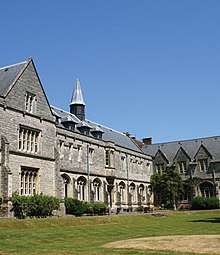Joseph Butler (architect)
Joseph Butler (1804–84), born in Parndon, Essex, was an architect, surveyor and builder. His specialist area was that of church buildings. He worked widely in Sussex, England.[1]

Career
Joseph Butler worked as surveyor in Chichester cathedral, where he supervised R C Carpenter's restoration from 1846.[1] Butler was responsible for the opening up of the sub-deanery in the cathedral and for its eventual removal to a new church Saint Peter the Great, Chichester.[2][3][4][5]
In 1849 Butler designed the Bishop Otter Memorial College, a college to train school teachers, Nairn and Pevesner described the [original] buildings as being of a 'sober neo-Tudor style' and were 'typically honest and unselfconscious'.[1][6][7]
When Chichester Cathedral Spire fell down after a storm in 1861, it was rebuilt by Sir Gilbert Scott. Before the disaster, Joseph Butler had carried out a survey of the cathedral. It was with the aid of his detailed drawings that a replica of the original spire was constructed.[2][8]
During the Victorian era there was a Gothic revival in the design and restoration of churches. Nairn and Pevesner were scathing in their criticism of many church architects of that era describing them as 'meddlers', however they credit Butler, who built in the Gothic style, as saving many dozens of village churches.[9]
Selection of work
Source: Sussex Parishes.[1] Lambeth Palace Library.[10]
Churches designed

- Chichester, - St. Paul (1836);
- St Peter the Great (1848-52 - worked as surveyor for R C Carpenter);
- Plaistow (1853–54);
- Stanmer (1838 – attributed[lower-alpha 1])
- Stedham (1850)
Churches restored or extended
- Appledram (1845);
- Bosham (1845);
- Brighton and Hove, - St Andrew's Church, Church Road, Hove (1833-35 - contractor[11])
- Compton (1849–51);
- Fishbourne (1847);
- Forest Row (1850);
- Lower Beeding (1852 – unexecuted);
- Mid Lavant (1844);
- Pagham (1838);
- Pyecombe (1842 – examined);
- Sidlesham (1840 – unexecuted);
- Southwick (1835 – extent of involvement uncertain);
- Stoughton (1844);
- Upper Beeding (1852)
Notes
- The architect was either Butler or a Ralph Joanes. A plan of the church and of the graveyard still survives and is signed by Butler. Joanes was clerk of works for the site, and when he signed the account off he described himself as an architect.[11]
References
- Allen, John (2016). "Sussex Parishes". Retrieved 25 July 2016.
- Hobbs, Mary, ed. (1994). Chichester Cathedral an Historical Survey. Chichester: Phillimore. pp. 148–153. ISBN 0-85033-924-3.
- Nairn, Ian; Pevsner, Nikolaus (1965). Sussex. The Buildings of England. Harmondsworth: Penguin Books. p. 171. ISBN 0-300-09677-1.
- Historic England. "Church of St Peter the Great, Chichester (1026613)". National Heritage List for England. Retrieved 27 July 2016.
- "Database of Manuscripts and Archives: St Peter the Great". CofE. Retrieved 27 July 2016.
- Green, Ken (2002). Chichester an Illustrated History. Breedon Books Publishing. pp. 103–105. ISBN 1-85983-336-5.
- Nairn, Ian; Pevsner, Nikolaus (1965). Sussex. The Buildings of England. Harmondsworth: Penguin Books. p. 173. ISBN 0-300-09677-1.
- Salzman, L F, ed. (1935). Chichester cathedral: Historical survey,. A History of the County of Sussex. 3. Victoria County History. pp. 105–113. Retrieved 13 July 2016.
- Nairn, Ian; Pevsner, Nikolaus (1965). Sussex. The Buildings of England. Harmondsworth: Penguin Books. p. 39. ISBN 0-300-09677-1.
- "Database of Manuscripts and Archives: Joseph Butler". C of E. Retrieved 27 July 2016.
- Berry, Sue (2011). Barber, Luke (ed.). "The impact of the Georgians, Victorians and Edwardians on early parish churches. CITY OF BRIGHTON AND HOVE c. 1680–1914" (PDF). Sussex Archaeological Collections. Lewes: Sussex Archaeological Society. 149: 210. ISSN 0143-8204.